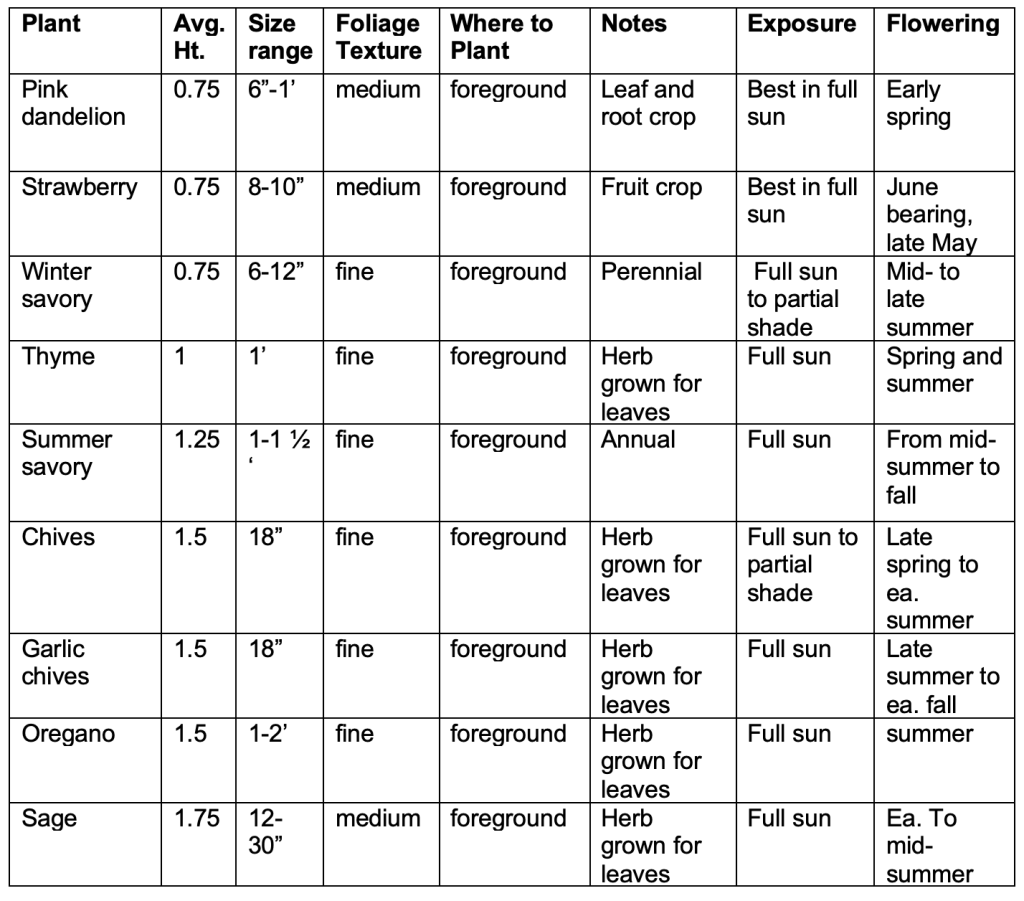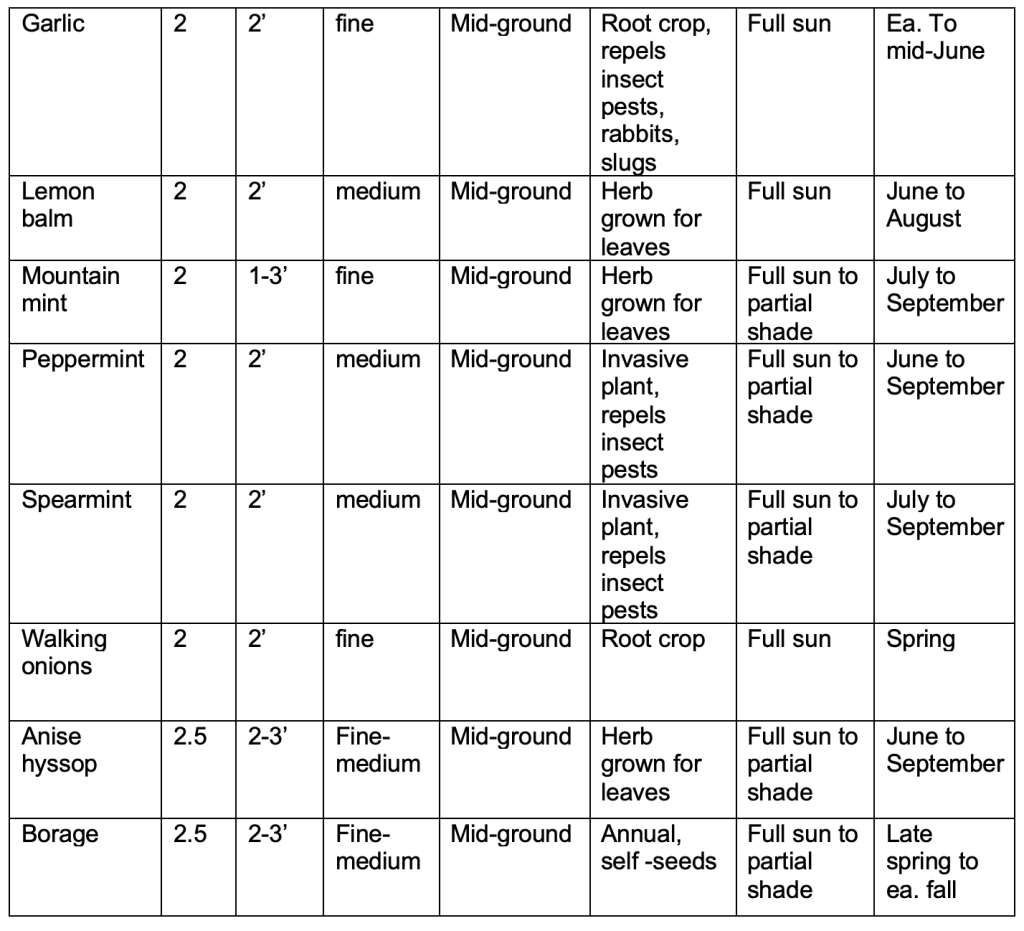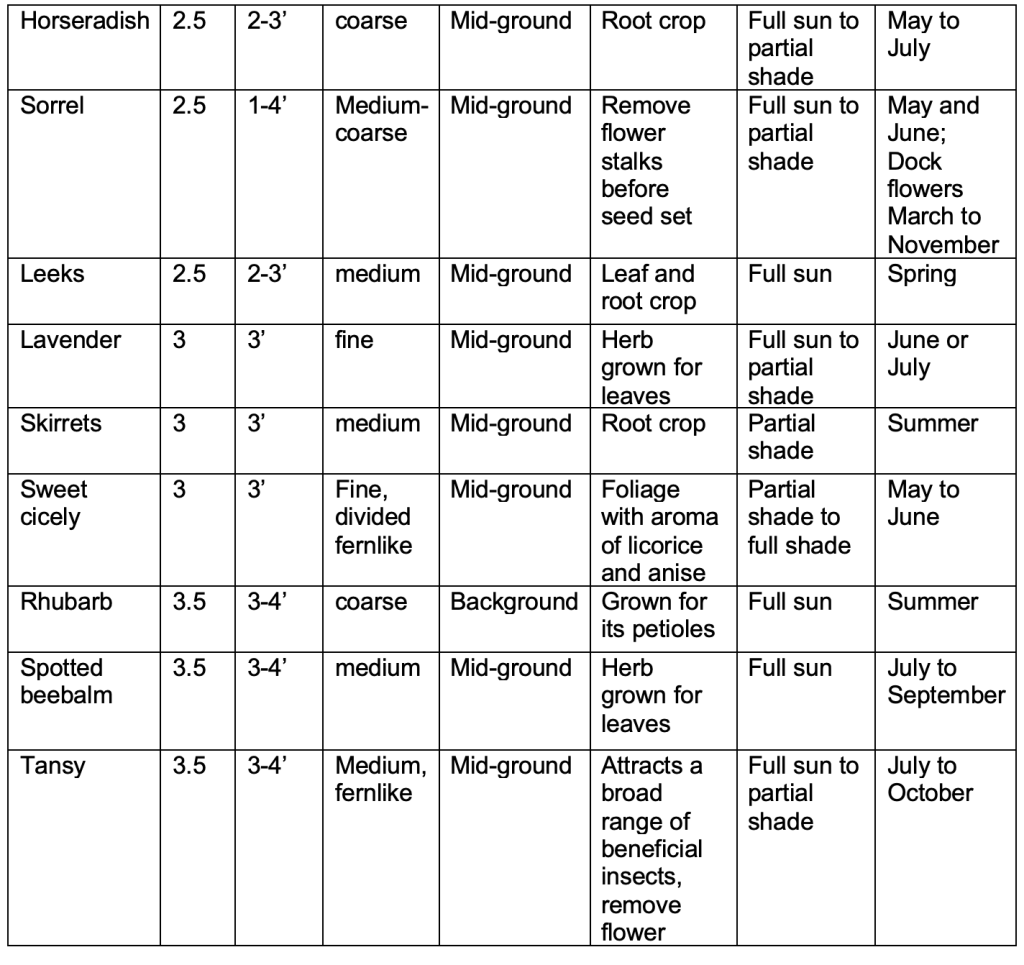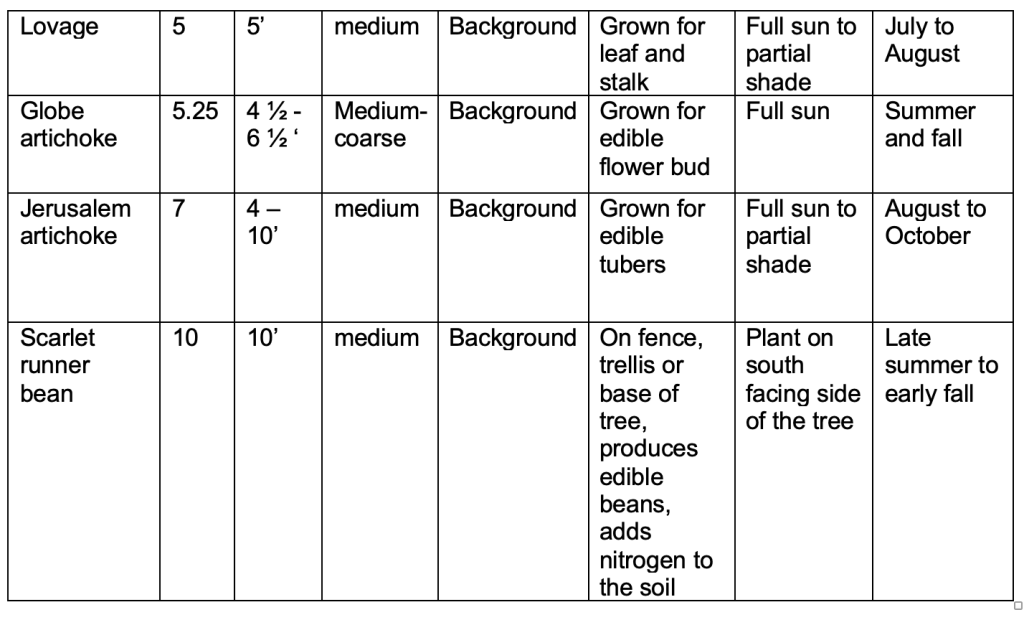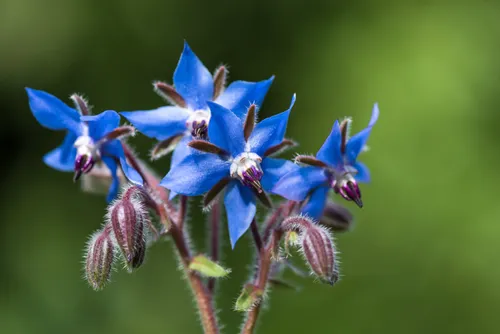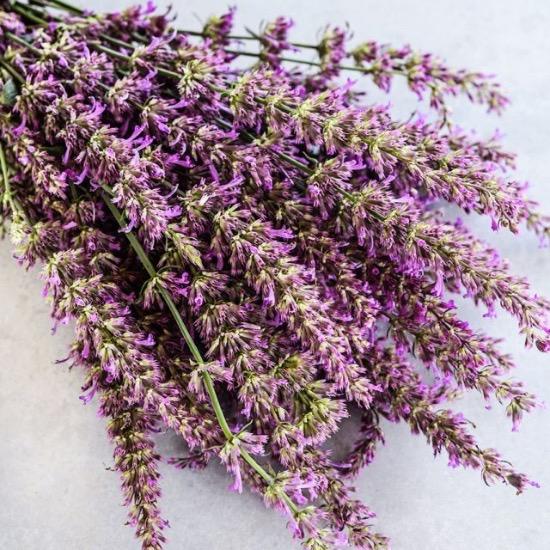 In this article, we’ll discuss some of the herbaceous biennial and perennial plants to add to the forest garden.
In this article, we’ll discuss some of the herbaceous biennial and perennial plants to add to the forest garden.
Here is a list of the plants we’ll consider:
Anise hyssop, asparagus, borage, burdock, cardoon, chicory, chives, fennel, garlic, garlic chives, globe artichoke, horseradish, Jerusalem artichoke, lavender, leeks, lemon balm, lovage, mountain mint, oregano, peppermint, pink dandelion, rhubarb, rosemary, sage, scarlet runner bean, skirrets, sorrel, spearmint, spotted beebalm, strawberry, summer savory, sweet cicely, tansy, thyme, walking onions, and winter savory.
Ten families are represented in the list of herbaceous plants including the Amaryllis, Asparagus, Aster, Borage, Crucifer, Legume, Knotweed, Mint, Rose and Carrot families. Why are there so many species of herbaceous (non-woody) plants alone?
For one, a mixed planting confuses pests. It makes it harder for the pest to find its host plant. This may have to do with the volatiles released by the aromatic species, or simply the visual “noise” of a mixed planting. Secondly, herbaceous plants in the various families attract pollinators, predators and parasitoids to the garden, the latter for pest control.
Thirdly, not all these species are necessarily adapted to your growing conditions. The environmental conditions required are the same for any living organism: water, minerals, temperature, air and sun. The conditions of place constitute its microclimate, which varies with region. Furthermore, a diversity of plant species serves as a basis for resiliency.
If space is an issue, select a combination of two species: one from the aster family and one from the carrot or mint family. A discussion of the plants follows.
The Amaryllis Family
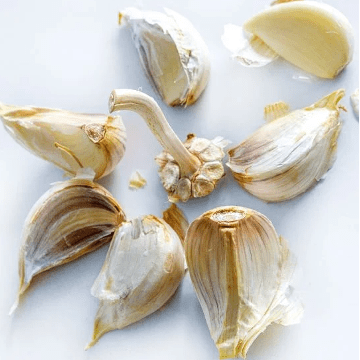
The Amaryllis family are herbaceous perennials that form bulbs, produce allyl sulfide compounds and include chives, garlic chives, garlic, walking onion and leeks. These plants produce edible shoots (fleshy leaves and scapes) and roots (bulbs). They also help to keep pests at bay.
Voles for example, will devour tulip bulbs (they did ours!), but avoid garlic, onion and daffodil bulbs! Some gardeners underplant roses with garlic to deter Japanese beetles from feeding. In our tree orchard and allée we underplanted garlic to deter voles from girdling the base of the trees.
Plant garlic sets in the fall, as voles and rabbits are active winter long. Whether this will work or not, I cannot say. But I will say it hasn’t deterred us from planting: we can’t grow enough garlic!
Walking onions or tree onion bulblets will sprout and grow while on the original stalk. Under the weight of the new growth, the stem bends to the soil and the bulblets take root away from the parent plant, giving rise to the name “walking onion”.
The Asparagus Family
Asparagus was once classified as a lily but now is in its own family. Native to Eurasia, herbaceous and perennial, asparagus evolved in maritime habitats in saline soils. Traditionally, salt was added to the bed to suppress weeds, but this practice excludes growing other plants in the same soil. The young shoots are used as a spring vegetable. Prepare the bed with good quality organic matter.
Properly prepared, asparagus will produce for years. Start the bed by planting crowns for an earlier harvest. Plant in full sun. Companion planting with tomatoes is said to deter asparagus beetle. I suggest interplanting with coreopsis, cosmos or marigolds (Aster family) and aromatic herbs like dill and coriander (Carrot family).
The Aster, Composite, Daisy or Sunflower Family
- Burdock, cardoon, chicory, globe artichoke, Jerusalem artichoke, pink dandelion, marigold and tansy are in the Composite family. The flower head of composites are just that: a group of individual florets on one base. They may be tubular disc flowers or ray flowers that sport a straplike petal, or in some cases, both.
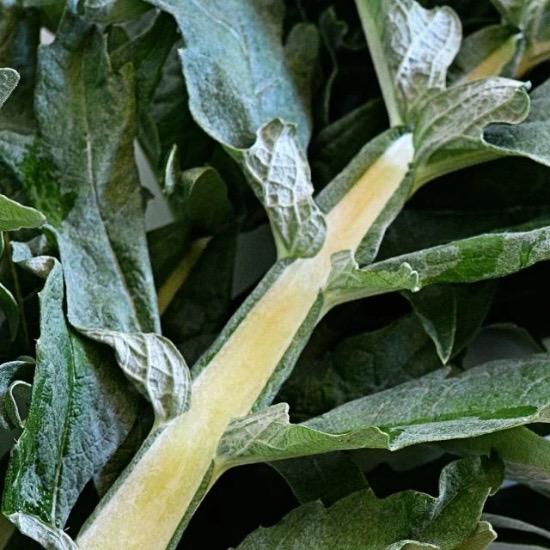
Burdock is native to Europe and Asia. Its seedheads (burrs) inspired velcro. Both roots and petioles are edible. The petioles taste much like artichoke. Cut the petiole from the leaf, discard the leaf, blanch and sauté. Burdock is easy to grow and often found growing in wayside places. Burdock flowers provide nectar and honey for honeybees in August when clover ends blooming and before goldenrod comes into bloom. To control its spread, remove the seedheads after flowering.
Cardoon, also called the artichoke thistle is native to the Mediterranean. It is adapted to dry climates. Grown for its edible stalks. Cardoon requires a long, cool growing season. It tolerates frosts, but not hard freezes. In areas of hard freezes grow as an annual plant.
Artichokes require good soil amended with compost and regular watering, and frost protection in winter. Rooted suckers can be planted each year, so mature specimens can be disposed of after a few years, as each individual plant lives only a few years. Adapted to Zones 7 and higher, a new cultivar, ‘Northern Star’, is said to be able to overwinter in more northerly climates and readily survives below zero temperatures.
Chicory, a perennial native to Europe and Asia and naturalized in the States is often found growing on roadsides. It is drought tolerant, prefers limestone soils, but is tolerant of a variety of soil conditions. Both leaf and roots are edible. The roots roasted and ground can be blended with coffee or used as a coffee substitute.
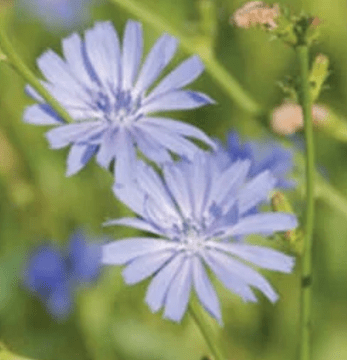
Jerusalem artichoke also called sunchoke is a species of sunflower, native to central North America. It is cultivated for its tuber, used as a root vegetable. It is competitive with weeds and may have allelopathic properties. It flowers from late summer into fall.
Pink dandelion (Taraxacum pseudoroseum), native to China grows to about 6-12”, and unlike its cousin (Taraxacum officinale), it is not invasive. It is attractive to pollinators, when few other plants are in bloom. Sow shallow, pressing the seeds into the soil. Like the lettuces, they need light to germinate. Dandelion has uses that exceed its reputation as a garden weed. The flowers can be used to make wine, the leaves blanched and eaten, and the roots roasted and ground for coffee.
Though considered a weed (which of course it is), dandelion (Taraxacum officinale) sends taproots deep into the soil and accumulates leached minerals, particularly calcium and magnesium. Their presence in the landscape are indicator plants for acidic soils. Test the soil pH and for mineral availability. Acidic soils tend to be deficient in the macro-elements particularly, phosphorous. To prevent dandelions from spreading, mow the flower stalks before they set seed.
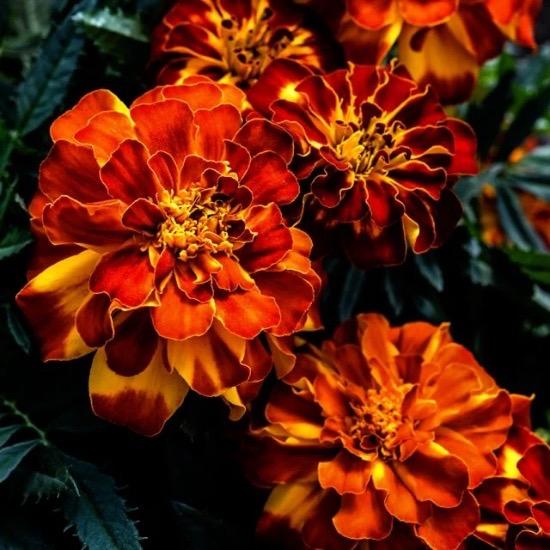
Marigold Summer blooming with single or double flowers ranging in colors of yellow, orange, rust and red, marigolds are grown as a summer annual. Plants grow anywhere from 6” to 30” tall, depending on the species. Marigolds attract hoverflies and parasitic wasps. There is evidence that it does repel nematodes. To repel nematodes, chop and turn the plants into the soil at flowering.
Tansy is grown as a companion plant and for biological pest control. It is easily grown and does not need amended soil as it can be invasive and weedy. Start plants from seed, which are sown directly in the garden bed. You can also divide existing clumps and replant to a new bed.
It is said to repel insect pests including ants, flea beetles, imported cabbageworms, Japanese Beetle, squash bugs, and Colorado potato beetle. But these effects may have more to do with the flowers being attractive to a broad range of predators and beneficial insects.
Remove the flower stalks after flowering and before they seed set to control its spread. In our developing tree orchard, we’ve mixed tansy seed with the cover crop seed to attract beneficial insects, and to increase the organic matter and nitrogen content of the soil.
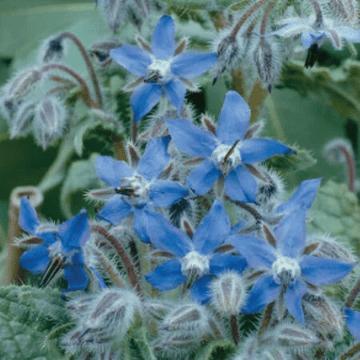
The Borage Family
Borage is not perennial, rather an annual that readily self-seeds. It produces an abundance of nectar, attractive to honeybees and other beneficial insects. Use as a companion plant to legumes, brassicas, tomatoes and strawberries.
The Crucifers (Mustards)
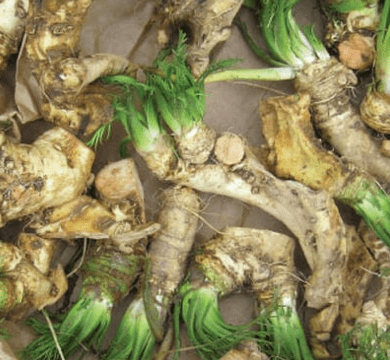
Horseradish, is a Eurasian native, grown primarily for its spicy roots. Its spiciness comes from the production of mustard oil (allyl isthiocyanate). It is a perennial, propagated from root cuttings in the fall.
The Legume, Pea or Bean Family
Scarlet runner bean, native to Central America is a perennial vine in warm regions, but grown as an annual in colder climates. In mild climates (Zones 7 – 11) it a short-lived perennial, forming tuberous roots from which new shoots resprout. It produces edible pods, and fixes nitrogen. The scarlet flowers attract hummingbirds. Plant on a tripod, a garden trellis or at the base of a tree for support. Grow in full sun in rich soil amended with organic matter.
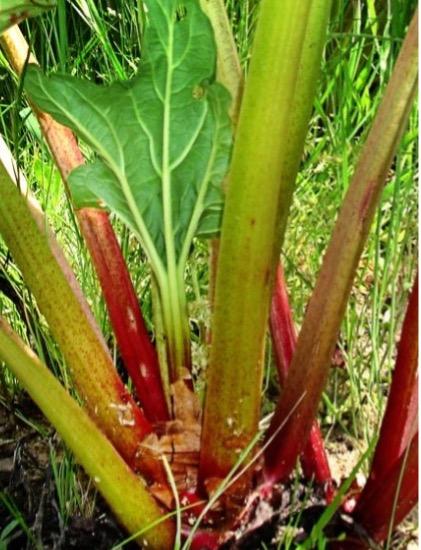
The Knotweed Family
Rhubarb is a perennial herb. Plant in full sun in moist, well-drained soil in spring as soon as the ground can be worked. Side-dress with a good compost. Space rhubarb crowns 3 feet apart. The stalks are edible; the leaf is not. Often used in pies (some call it “pie-plant”). The plant is coarse textured with large leaves. Some varieties have a red petiole, which makes for an attractive ornamental.
Sorrel (Rumex acetosa) is a perennial herbaceous plant also called garden sorrel or narrow-leaved dock. Native to Eurasia, it is common in grasslands. The leaves and shoots are edible when young. They are high in Vitamin C and have a lemony flavor. It can grow in poor soil.
Sheep sorrel or red sorrel (Rumex acetosella), referred to as dock is also a perennial herbaceous plant native to Eurasia commonly occurs here as a weed plant. It is common in acidic soils and grasslands. It contains oxalates, which imparts a lemony tang, almost rhubarb-like flavor. It can be eaten raw or cooked. Cooking reduces its strong flavor. Drain off the water to eliminate the oxalates.
Though considered weeds (which of course they are), both sorrel and dock send taproots deep into the soil and accumulate leached minerals, such as calcium and magnesium. Their presence in the landscape are indicator plants for acidic soils. As such, test the soil pH and for mineral availability. Acidic soils tend to be deficient in the macro-elements particularly, phosphorous. To prevent sorrel from spreading, remove the flower stalks before they set seed.

The Mint Family
- Anise hyssop, lavender, lemon balm, mountain mint, oregano, peppermint, rosemary, sage, spearmint, spotted beebalm, summer savory, thyme, and winter savory are all in the mint family.
Anise hyssop grows in well-drained soils in full sun to partial shade. Anise hyssop spreads by rhizomes and self-seeds. It is found growing in dry, upland forest areas and fields. Grows 2-4’ tall. Its foliage is anise scented. The flowers are attractive to bees, butterflies and hummingbirds. Plant in borders, the wildflower garden or in meadows.
Lavender is an evergreen perennial shrub native to the Mediterranean. It requires good drainage and prefers neutral to alkaline soils. It grows 2 feet tall and 3 feet wide. Well suited to the border, pollinator garden, edible and herb gardens. Has aromatic foliage and flowers that are attractive to pollinators.
Lemon balm is a perennial herbaceous plant native to Eurasia that grows to 3 ½ feet. Its leaves have a mild lemon scent. The leaves are used as an herb and in teas. The leaves contain volatile oils including eugenol and terpenes. The seed needs light to germinate, and temperatures of at least 68F.
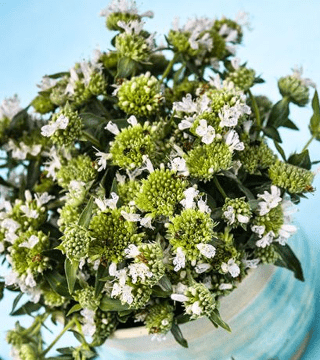
Mountain mints are a group of plants native to North America. The leaves have a strong, minty flavor and can be used in making tea. They grow in moist to dry, well-drained soil in sun to part shade. Use in naturalized areas, native, pollinator or edible gardens.
Oregano, is a genus of subshrubs and herbaceous perennials in the mint family grown primarily as ornamentals or culinary herbs. Oregano may grow in bushy mounds, prostrate, or erect. The plants may measure 6 inches to 3 feet in height and 1 to 2 feet in width. The leaves are aromatic, small oval to round, and either smooth or hairy. The blooms may be white, pink, or purple and appear in small 1-inch spikes, panicles, or corymb. The different species can vary in flavor, aroma, size, and color.
Oregano is native to Europe, Central Asia, the Mediterranean, and North Africa. It was introduced to the United States after World War II.
Oregano prefers full sun and needs well-drained to dry soil that is neutral or alkaline. They are intolerant to acidic soils, poorly drained soils, and hot humid conditions. Oregano is tolerant of drought, deer, poor soil, and erosion. They may be propagated by seeds, cuttings, or division. Bees and butterflies are attracted to their blossoms.
There are many different types of oregano with different flavor profiles. Culinary uses of oregano include flavoring tomato sauces, soups, stews, and pizza.
Plants from the genus Origanum may be used in herb gardens, cottage gardens, and rock gardens. They may serve as a groundcover, borders, or container plant.
The culinary herbs include:
- Origanum majorana (Sweet marjoram)
- Origanum x majoricum (Italian Oregano)
- Origanum vulgare (Oregano or Wild Marjoram)
Peppermint is an upright perennial herb that is a cross between wintermint and spearmint. It is grown as a culinary or medicinal herb and/or a ground cover. It spreads by rhizomes forming an attractive, though aggressive, ground cover. It repels ants and mice.
It prefers rich moist soil in partial shade but has a wide tolerance of soil and light conditions. It does best in neutral soils (pH of 6.0-7.0). It does well in part shade, only needing a minimum of three hours of sun a day. Space plants 18″ apart.
Use flowers and leaves fresh or dried in teas, beverages, jellies, and syrups. Regularly pinching off the branch tips will promote bushier, leafier growth, increasing available harvest.
Rosemary is an aromatic, perennial, evergreen shrub that is valued for its fragrant, ornamental foliage. The shrub is generally erect and rounded. The aromatic, needle-like leaves are green on the upper surface, and tomentose below. It is cultivated as an ornamental, as a culinary herb, or for use in sachets or potpourris.
It is native to Africa, Europe, Western Asia, and the Mediterranean.
Rosemary does best well-drained soils in full sun. It’s tolerant of drought, partial shade, salt, heavy pruning, and most soils. It is easily transplanted and rooted. However, it does not tolerate wet, humid environments and clay soils. Its’ flowers attract butterflies, bees, and hummingbirds. Once the bloom has passed, prune to encourage foliar growth.

Rosemary is suited to many types of landscapes and gardens: pollinator, edible, and cutting gardens. It is winter hardy in Zones 8 and higher. In colder regions, grow as an annual. Take cuttings in the fall and start a new plant. Alternatively, grow in a pot, and bring indoors for the winter.
Sage. Most members of this genus are small upright shrubs reaching 1 to 3 feet tall and wide.
Plant in full sun to part shade and in well-drained soil amended with organic matter. They are drought and salt tolerant and resistant to deer. Propagate by division, seed, or stem cutting.
The flowers provide excellent late season color, so sages are a good companion plant in a native, butterfly, pollinator or herb garden.
Spearmint is a flowering, aromatic herb or groundcover native to Europe. In its natural habitat it is found growing in moist fields and pond or lake margins.
This upright perennial thrives in full sun in organically rich, well-drained, moist soils growing quickly 1 to 2 feet high and wide with bright green leaves and shoots. It tolerates partial shade and a wide range of soil types, except dry soils. The stems can root wherever they touch the ground, and it also spreads by rhizomes. Soil barriers can restrain rhizomatous spread if plants are grown in borders or other areas where spread is unwanted.
Best grown in a container or raised bed as it spreads rampantly. This trait, however, can be an advantage if the plants are grown as a ground cover in moist areas.
Shear after bloom to remove flower spikes and stimulate new vegetative growth. Leaves have a strong spearmint fragrance and taste, and may be used to flavor teas, in salads, as a garnish or in potpourris. It is widely used for culinary purposes and is known as one of the best mints for flavor. Use the flowers and leaves fresh or dried in teas, jellies, syrups, and ice creams.
Spotted beebalm is a native herbaceous perennial to the eastern U.S. and typically occurs in full sun areas with dry soil in sandy areas, and in rocky woodlands. It is clump-forming, growing to 1′-2′ tall. It is susceptible to powdery mildew. Thin stems to increase air flow to reduce disease incidence.
Summer Savory is an edible, aromatic herb, and with culinary and medicinal value. It has a mild peppery taste and is often used to flavor soup and tea. The plant is grown from seed in early spring and harvested in the summer when in flower and can be used fresh or dried. It is grown as an annual, unlike Winter Savory, which is perennial.
Summer Savory grows in moist, alkaline soil rich in organic matter, in full sun. However, it does not do well in poorly drained soil or in shade. Savory is a good companion plant in the garden to repel insect pests with onions and beans. The flowers are very attractive to bees.
Common thyme is a woody, broadleaf evergreen perennial in the mint family (Lamiaceae) native to Southwestern Europe and southeastern Italy.
It performs best in dry, sandy, or rocky soils, prefers full sun, and needs good drainage. It grows best in soils that are neutral to alkaline. It is frost and drought tolerant. Common thyme is a low-maintenance plant, but it should be trimmed whenever it gets leggy. Cut it back in early spring and summer to reduce its woody growth. Transplanting or dividing is best done in the early spring. The best methods of propagation are stem cuttings, layering, or division.
Grown primarily as an aromatic culinary herb, common thyme forms a mound about 6 to 12 inches high and up to 16 inches wide. Harvest it just before it flowers when the essential oil content of the leaves is at its peak. It is recommended to cut five to six inches off the top growth and leave the woody stems. The leaves are very fragrant which makes the plant less attractive to browsing deer.
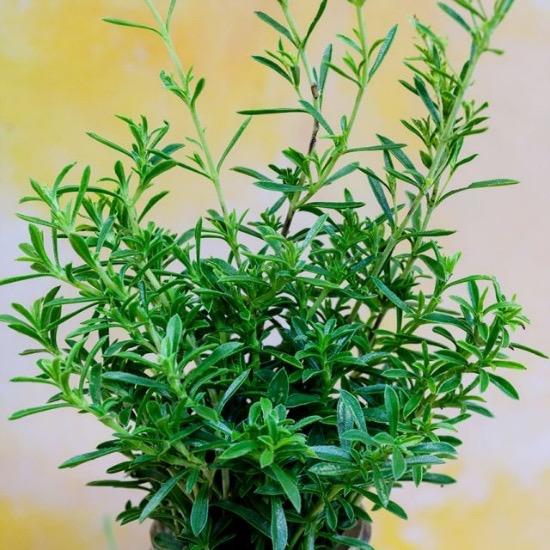
In addition to an edible or herb garden, common thyme makes a great addition to a pollinator garden. The flowers are attractive to bees, butterflies, and other pollinating insects. Use in the cottage, cutting, rock, or herb gardens. Plant it in small groups or as a border in a naturalized area, or along a walkway. Common thyme does well in a container indoors or outside.
Winter Savory is an edible, aromatic perennial herb, with a culinary and medicinal value. It is a low-growing, shrubby plant with edible flowers that have a spicy, peppery taste and leaves that are used to flavor salads, soup, and stews. In addition to its culinary value, Winter Savory can also be used as an ornamental border or edging in the garden. The plant is grown from cuttings or seed in early spring and harvested in the summer when in flower and can be used fresh or dried. Winter Savory is a good companion plant for onions and beans to repel insect pests.
Grow winter Savory in well-drained, alkaline soil in full sun. The plant tolerates partial shade. It is a fast-growing plant, can be harvested within 2 months of sowing. Prune to remove dead wood in early spring. The flowers are very attractive to bees.
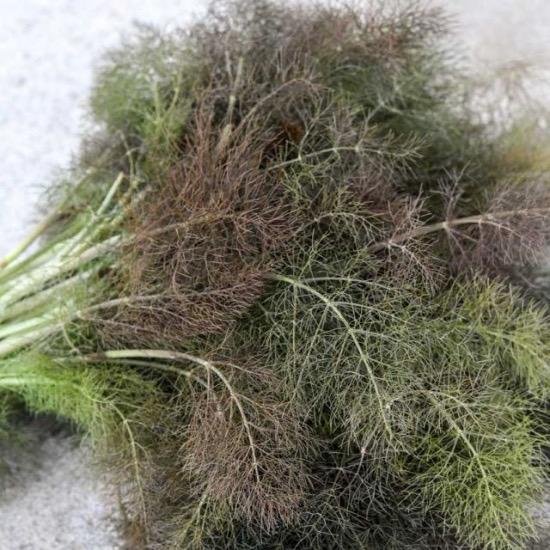
The Carrot (Umbel) Family
- Fennel, lovage, skirrets, sweet cicely
Fennel is indigenous to the Mediterranean, and widely naturalized on dry soils in coastal areas and along riverbanks. It contains aromatic and volatile oils (anethole) imparting anise-like and licorice-like flavors. It naturalizes along roadsides and in pastures. It may be allelopathic to some plants. Attracts hover and tachinid flies, lady beetles and parasitic wasps.
Lovage is a perennial herbaceous plant with flavor and aroma reminiscent of parsley and celery. Large and celery-like, it grows to 5 feet. Small yellow flowers in umbels attracts beneficial wasps.
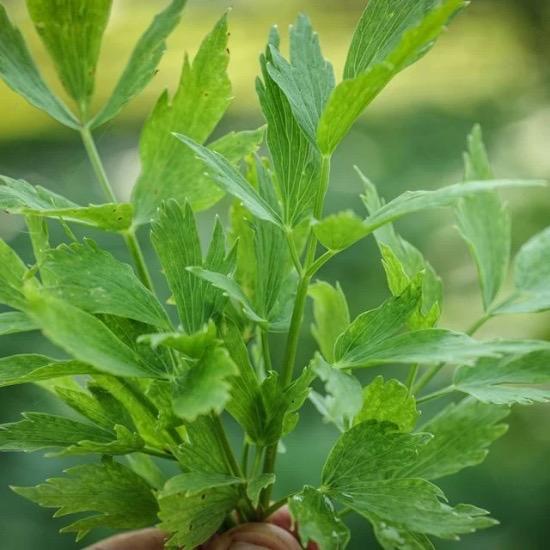
Skirret is an obscure, almost forgotten root vegetable. It has a carrot-like flavor. Grows to 40” and is resistant to cold and pests and diseases. Plant in well-drained, moist soil in partial shade to full sun.
Cicely, sweet cicely or garden myrrh is an herbaceous perennial smelling strongly of anise when crushed. It grows 6 ½ feet tall, and 3 ½ feet wide. A Eurasian native, it has become naturalized in woodland margins, roadsides and riverbanks. Like fennel, it contains essential oils, predominately anethole. It can be grown in partial shade. Like fennel, it attracts beneficial wasps and flies.
Skirret is an obscure, almost forgotten root vegetable. It has a carrot-like flavor. Grows to 40” and is resistant to cold and pests and diseases. Plant in well-drained, moist soil in partial shade to full sun.
Cicely, sweet cicely or garden myrrh is an herbaceous perennial smelling strongly of anise when crushed. It grows 6 ½ feet tall, and 3 ½ feet wide. A Eurasian native, it has become naturalized in woodland margins, roadsides and riverbanks. Like fennel, it contains essential oils, predominately anethole. It can be grown in partial shade. Like fennel, it attracts beneficial wasps and flies.

The Rose Family
Strawberry is in the rose family, grown for its berries (an aggregate fruit). Plant crowns in spring in soil amended with a good quality compost. Set crowns 12” apart. Most importantly, don’t bury too deeply (the crown is a compressed stem). Mulch plants in with (what else?) straw. The straw mulch keeps the fruit from rot, should it come in contact with the soil. Slugs and birds both love strawberries.
Gardening with Herbs
The plant form and habit suggest how they may be used in the landscape garden. The chart suggests their placement within a group based on their average height, foliage texture, exposure, and approximate time of bloom.
Here are some of my gardening recommendations:
- Place low growing plants (pink dandelion, strawberry, winter savory, chives, oregano, etc.) in the foreground, plants intermediate in height (lemon balm, mountain mint, borage, cardoon, etc.) midground, and taller plants (Jerusalem artichoke, lovage, rhubarb) in the background.
- Planting large, coarse foliaged plants (burdock, rhubarb) with fine textured plants (sweet cicely, fennel) creates contrast and interest.
- Set apart plants with striking foliage (size, color, shape) as specimens. Examples are cardoon (silvery foliage), rhubarb (red large leaved), lovage and tansy (dark green, fernlike).
- Place sun loving plants in the planting bed where they’ll get the most sunlight.
- Plants that bear fruit (strawberries) or form bulbs (garlic, onions, leeks) do best in full sun
- Plants that are grown for foliage (peppermint, spearmint, borage, sorrel, tansy, etc.) do well in partial shade
- Include a minimum of one composite (tansy, marigold, coreopsis, cosmos) and one umbel (sweet cicely, fennel, lovage) in a planting or,
- Plant a composite with a member of the mint family (winter savory, thyme, rosemary, oregano, sage, lemon balm, mountain mint, anise hyssop, etc.)
- Planting a bed with herbs that flower over the entire growing season will support pollinators and beneficial insects by providing a steady supply of pollen and nectar. For example, a planting of pink dandelion (early spring), thyme (spring and summer), chives (late spring to ea. summer), winter savory (mid- to late summer), lovage (July to August), and scarlet runner beans (late summer to early fall) will support pollinators from early spring through the fall.
